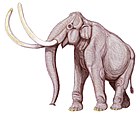劍齒象屬
| 劍齒象屬 | |
|---|---|

| |
絕滅(公元前2150年)
| |
| 科學分類 | |
| 界: | 動物界 Animalia |
| 門: | 脊索動物門 Chordata |
| 綱: | 哺乳綱 Mammalia |
| 目: | 長鼻目 Proboscidea |
| 科: | †劍齒象科 Stegodontidae |
| 屬: | †劍齒象屬 Stegodon Falconer, 1847 |
| 種 | |
| |
劍齒象屬(學名:Stegodon),命名自其具有高聳齒脊的臼齒,為長鼻目劍齒象科下已滅絕的一屬。牠們最早被分類至象科,之後才被分類至獨立的劍齒象科下[1]。劍齒象生活在距今1160萬-11,000年前的更新世晚期,另外也有部分研究則指出有些劍齒象可能存活至約4,100年前。地理分布橫跨亞洲和非洲的中部與東部、以及華萊士區,最東至帝汶[1][2][3]。
形態學
[編輯]

體型
[編輯]劍齒象屬包含了部分長鼻目中體型最大的物種,其中於黃河出土的師氏劍齒象(S. zdansky)化石,屬於老年雄性個體(超過50歲),肩高達3.87米(12.7英尺)、肱骨長1.21米(4.0英尺)、股骨長1.46米(4.8英尺)、骨盆寬度達2米(6.6英尺)[4]、體重估計可達12.7公噸(12.5長噸;14.0短噸)。除了師氏劍齒象(S. zdansky)外,其他物種如 華麗劍齒象(S. ganesha)、三重劍齒象(S. miensis)、東方劍齒象(S. orientalis)、類象劍齒象(S. elephantoides)、獨特劍齒象(S. insignis)與凱氏劍齒象(S. kaisensis),體型也都與現存象體型近似。這些大體型的劍齒象主要棲居於大陸,而棲居於島嶼的曙光劍齒象(S. aurorae)、三角頭劍齒象(S. trigonocephalus)與大弗洛勒斯倭劍齒象(S. florensis florensis)體型則有侏儒化的趨勢。
侏儒化
[編輯]和現存的大象一樣,劍齒象同樣擁有很好的游泳能力[5][6],也因此牠們的化石可以在許多亞洲地區的島嶼上發現,例如印尼的蘇拉威西島、弗洛勒斯島、帝汶、松巴島;菲律賓的呂宋、民答那峨島;台灣以及日本,其中有部分島嶼即使在更新世冰河期水位較低時也沒有與亞洲大陸形成陸橋連結,且許多棲息於島嶼上的劍齒象有島嶼侏儒化的趨勢。目前已知體型最小的劍齒象為松巴島的松巴劍齒象(S. sumbaensis)[7],體重約僅有250公斤(550英磅)[8]。體型稍大的小弗洛勒斯倭劍齒象(S. sondaari),發現於印尼弗洛勒斯島更新世早期的地層,體重約為355—650公斤(783—1,433英磅)[8];另外一項估計肩高為1.2米(3.9英尺),體重約為350—400公斤(770—880磅)[4]。棲息於菲律賓的劍齒象(S. luzonensis與S. mindanensis)也具有與小弗洛勒斯倭劍齒象(S. sondaari)和蘇拉威西倭劍齒象(S. sompoensis)近似的體型[9],其中民答那峨劍齒象(S. mindanensis)的體重約為400公斤(880磅)[10]。在850,000年前印尼弗洛勒斯島上,棲息著體型較大的大弗洛勒斯倭劍齒象(S. florensis),體重約為1,700公斤(3,700磅);在這之後大弗洛勒斯倭劍齒象演化成體型較小的島嶼劍齒象(S. florensis insularis),體重約為570公斤(1,260磅)[8][11](但另一項估計肩高為2米(6.6英尺),體重約為2 t(2.0 long ton;2.2 short ton)[4]);牠們的化石可以在島上的梁布亞岩洞發現。島嶼劍齒象被同時代的人族佛羅勒斯人狩獵,而這些佛羅勒斯人約於49,600年滅絕[12],略早於之前所作的估計值[13]。這些體型較小的劍齒象也被認為是現今仍存在的科莫多龍的主要獵物,直到人類來到這些島嶼並帶來了馬來豬、鬣鹿及水牛[14]。



生存年代
[編輯]共有130篇論文提到於中國南方180個不同的地點發現劍齒象屬的遺骸,顯示當時於當地的劍齒象數量可能多於亞洲象,且最年輕的化石遺骸經過放射性鑑定後,估計該個體約存活於4,100年前[2]。然而,特維(Turvey)等人於2013年提出部分化石,包括前面提到的全新世劍齒象化石(發現於四川省古藺縣)實際上均是來自更新世晚期,而其他的全新世劍齒象樣本多半已經遺失,無法進行驗證。特維提出的結論是最後存活的劍齒象是活於更新世晚期,目前仍無證據可以證明劍齒象有存活至全新世[15] 。
種類
[編輯]| 學名 | 中文名 | 出土地 |
|---|---|---|
| Stegodon aurorae | 曙光劍齒象 | 日本、台灣 |
| Stegodon elephantoides | 類象劍齒象 | 緬甸、爪哇島、台灣 |
| Stegodon florensis | 大弗洛勒斯倭劍齒象 | 弗洛勒斯島 |
| Stegodon ganesha | 華麗劍齒象 | 印度 |
| Stegodon kaisensis | 凱氏劍齒象 | |
| Stegodon luzonensis | 呂宋劍齒象 | 菲律賓 |
| Stegodon miensis | 三重劍齒象 | 日本、台灣 |
| Stegodon mindanensis | 民答那峨劍齒象 | 菲律賓 |
| Stegodon orientalis | 東方劍齒象 | 中國、日本、台灣 |
| Stegodon sompoensis | 蘇拉威西倭劍齒象 | 蘇拉威西島 |
| Stegodon sondaari | 小弗洛勒斯倭劍齒象 | 弗洛勒斯島 |
| Stegodon sumbaensis | 松巴劍齒象 | 松巴島 |
| Stegodon trigonocephalus | 三角頭劍齒象 | 爪哇島 |
| Stegodon zdanski | 師氏劍齒象(黃河象) | 中國 |
| Stegodon insignis | 獨特劍齒象 | 印度、台灣 |
種系發展
[編輯]
| ||||||||||||||||||||||||||||||||||
參考
[編輯]- ^ 1.0 1.1 PaleoBiology Database: Stegodon, basic info. [2021-07-08]. (原始內容存檔於2012-10-13).
- ^ 2.0 2.1 H. Saegusa, "Comparisons of Stegodon and Elephantid Abundances in the Late Pleistocene of Southern China 網際網路檔案館的存檔,存檔日期2006-05-08.", The World of Elephants -- Second International Congress, (Rome, 2001), 345-349.
- ^ Louys, Julien; Price, Gilbert J.; O』Connor, Sue. Direct dating of Pleistocene stegodon from Timor Island, East Nusa Tenggara. PeerJ. 2016-03-10, 4: e1788. ISSN 2167-8359. PMC 4793331
 . PMID 26989625. doi:10.7717/peerj.1788
. PMID 26989625. doi:10.7717/peerj.1788  .
.
- ^ 4.0 4.1 4.2 Larramendi, A. Shoulder height, body mass and shape of proboscideans (PDF). Acta Palaeontologica Polonica. 2016, 61 [2021-07-04]. S2CID 2092950. doi:10.4202/app.00136.2014
 . (原始內容 (PDF)存檔於2016-08-24).
. (原始內容 (PDF)存檔於2016-08-24).
- ^ Simpson, G. (1977). Too Many Lines; The Limits of the Oriental and Australian Zoogeographic Regions. Proceedings of the American Philosophical Society, 121(2), 107-120. Retrieved from http://www.jstor.org/stable/986523 (頁面存檔備份,存於網際網路檔案館)
- ^ Bird, Michael I.; Condie, Scott A.; O』Connor, Sue; O』Grady, Damien; Reepmeyer, Christian; Ulm, Sean; Zega, Mojca; Saltré, Frédérik; Bradshaw, Corey J. A. Early human settlement of Sahul was not an accident. Scientific Reports. 2019, 9 (1): 8220. PMC 6579762
 . PMID 31209234. doi:10.1038/s41598-019-42946-9.
. PMID 31209234. doi:10.1038/s41598-019-42946-9.
- ^ Turvey, Samuel T.; Crees, Jennifer J.; Hansford, James; Jeffree, Timothy E.; Crumpton, Nick; Kurniawan, Iwan; Setiyabudi, Erick; Guillerme, Thomas; Paranggarimu, Umbu; Dosseto, Anthony; van den Bergh, Gerrit D. Quaternary vertebrate faunas from Sumba, Indonesia: implications for Wallacean biogeography and evolution. Proceedings of the Royal Society B: Biological Sciences. 2017-08-30, 284 (1861): 20171278. PMC 5577490
 . PMID 28855367. doi:10.1098/rspb.2017.1278.
. PMID 28855367. doi:10.1098/rspb.2017.1278.
- ^ 8.0 8.1 8.2 van der Geer, Alexandra A. E.; van den Bergh, Gerrit D.; Lyras, George A.; Prasetyo, Unggul W.; Due, Rokus Awe; Setiyabudi, Erick; Drinia, Hara. The effect of area and isolation on insular dwarf proboscideans. Journal of Biogeography. 2016, 43 (8): 1656–1666 [2021-07-04]. doi:10.1111/jbi.12743. (原始內容存檔於2021-07-09) (英語).
- ^ Hooijer, D.A. Quaternary Mammals West and East of Wallace’s Line. Netherlands Journal of Zoology. 1974, 25: 46–56. doi:10.1163/002829675x00128 .
- ^ Ong, Perry. The Philippine Menagerie. The Philippine Archipelago. Makati city, Philippines: Asia Publishing Co. Ltd. 1998: 227–255 [2021-07-04]. (原始內容存檔於2021-07-09).
- ^ Van Den Bergh, G.D., Aweb, R.D., Morwoodc, M.J., Sutiknab, T., Jatmikob and Saptomo, E. W. 2008. The youngest stegodon remains in Southeast Asia from the Late Pleistocene archaeological site Liang Bua, Flores, Indonesia. Quaternary International 182(1): 16-48.
- ^ Sutikna, Thomas; Tocheri, Matthew W.; Morwood, Michael J.; Saptomo, E. Wahyu; Jatmiko; Awe, Rokus Due; Wasisto, Sri; Westaway, Kira E.; Aubert, Maxime; Li, Bo; Zhao, Jian-xin. Revised stratigraphy and chronology for Homo floresiensis at Liang Bua in Indonesia. Nature. April 2016, 532 (7599): 366–369 [2021-07-04]. ISSN 0028-0836. PMID 27027286. S2CID 4469009. doi:10.1038/nature17179. (原始內容存檔於2021-07-01) (英語).
- ^ Van Den Bergh, G. D.; Rokhus Due Awe; Morwood, M. J.; Sutikna, T.; Jatmiko; Wahyu Saptomo, E. The youngest Stegodon remains in Southeast Asia from the Late Pleistocene archaeological site Liang Bua, Flores, Indonesia. Quaternary International. May 2008, 182 (1): 16–48. Bibcode:2008QuInt.182...16V. doi:10.1016/j.quaint.2007.02.001.
- ^ Diamond, Jared M. (1987). "Did Komodo dragons evolve to eat pygmy elephants?". Nature. 326 (6116): 832.
- ^ Samuel T. Turvey, Haowen Tong, Anthony J. Stuart and Adrian M. Lister. Holocene survival of Late Pleistocene megafauna in China: a critical review of the evidence. Quaternary Science Reviews. 2013, 76: 156–166. Bibcode:2013QSRv...76..156T. doi:10.1016/j.quascirev.2013.06.030.




